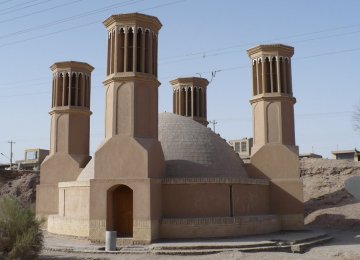The scorching sun of the desert has compelled desert dwellers to build lofty walls, narrow streets, highly elevated wind towers (aka wind traps), water reservoirs and arched chambers, the outstanding features of desert towns in Iran.
Wind towers are distinctive features of cities in Yazd Province. They are considered respiratory tracts of the city. Most of them belong to old residential houses. The majority of urban reservoirs and mosques are equipped with wind towers.
In ancient times, wind traps functioned like the present modern air conditioning system. A wind trap tower directs the natural air current to different sections of the building. The size and adornments of wind traps could tell much about the distinction and social standing of the owners.
The operation of modern coolers is similar to old Iranian wind towers usually built at the entrance of the house over underground water reservoirs or ponds built inside the house.
In cities where suitable wind is blowing from a fixed direction, the wind traps are open at one direction and closed from the other three directions.
Wind trap is a chimney with lower end in the underground and upper end set over a specific height on the roof. The upper inlet has many small openings. The lower part of the duct terminates in a reservoir whose water is provided by 'qanat' or underground aqueduct.
Food Preservation
By the underground reservoir a place was designed for the inhabitants to repose or preserve their foodstuff in summers.
Wind trap operates with the change of air temperature resulting in difference of air weight inside and outside the trap. When this happens, the air is sucked into the duct.
Air circulation in various points of the building can be adjusted by opening or closing the various hatches at the bottom of the wind trap.
Walls absorb a lot of heat during daytime. The light, warm air inside the wind trap ascends and is blown to upper elevations. As a result, cool air flows from windows and doors into the house and circulates through the night. If it is windy, the air circulates in the opposite direction; that is, the wind trap draws the cool air into the house.
During daytime the air trap acts contrary to a chimney; the upper part of the wind trap has been cooled the night before. Upon contacting the wall of the wind trap, the warm air cools, descends, eventually circulates through the house, and exits from doors and windows. The flow of daytime air accelerates the ventilation process.
For each hatch facing the wind, another hatch is set in the opposite direction. While some wind traps only change the air temperature, others change the moisture too; the water reservoir set at the bottom of the wind trap, the coolest place in the building, is normally located underground. It gives off cool moisture into the wind trap.
A part of the wind directly blows into the water reservoir. It cools the reservoir and protects it from stagnation and pollution. Then, the cool breeze is transferred to halls and summer quarters.
In certain desert regions where wind blows at various elevations, we can see air traps with two outlets at two different heights.
Excerpted from the article 'Wind Catchers' published by the Circle of Ancient Iranian Studies.





